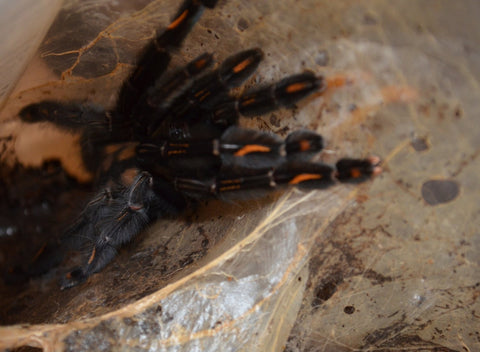Venezuelan Suntiger Tarantula Care
Venezuelan Suntiger Tarantula Care Guide
Basic Information
The Venezuelan Suntiger Tarantula is an arboreal tarantula native to Venezuela and found in parts of Brazil and Guyana. It grows to be around 5-6 inches long and is relatively fast-growing. Females live much longer, between 10 and 20 years, while males live only around 5-6 years. They have beautiful orange and red markings on their legs and stripes on their abdomen, giving them the name sun tiger. This new world tarantula species is considered intermediate level for keepers as they are more aggressive, defensive, and have potent venom.
Health
Regarding handling, it is not recommended to handle Suntiger tarantulas unless you are an experienced handler. This species of tarantula is swift and skittish and can also jump. They are also known for being extremely defensive and will resort to biting. Suntigers are not only a risk to you but also to themselves, as tarantulas are fragile. If they fall from a considerable enough distance, they can rupture their abdomens, resulting in death. If you need to handle them, use tongs or a tool to coerce them into moving somewhere.
All tarantulas go through a period of molting. Molting for a tarantula is when they shed their old exoskeleton and replace it with a new one. The signs to look for are: the tarantula is still and not eating, the spider is lying on its back, and its legs are curled. This is entirely normal. What is essential is that there is no feeding or handling during this time. Tarantulas are very vulnerable and easily susceptible to stress during this period, and because they are so soft and unable to move, live food may damage them. It's recommended that they are not fed or handled for at least 2 weeks or until the new exoskeleton is hardened, which can be identified if the new fangs are hardened.
Enclosures
Spiderling tarantulas can be kept in small deli cups with the appropriate substrate. As they grow, they can be moved to taller deli cups or critter cages until they are fully grown and ready to move to a proper enclosure. Adult tarantulas do not need much space, but because this is an arboreal species, you want to ensure their enclosure focuses on height. An 8x8x12-sized enclosure is recommended that contains enough space for an adult suntiger. Alternatively, you can modify a large plastic container into an enclosure. Be sure that whichever enclosure you choose has enough airholes for ventilation, but not too many that it affects the humidity levels. For decorations, cork bark leaning against the sides of the enclosure is recommended. This will allow the tarantula to create its webs and have ample hiding spaces—otherwise, there's free range for decoration choices.
Heating/Lighting
Suntiger tarantulas need no additional lighting. It is best to simulate a natural day-night cycle as they are nocturnal. Extra lighting may stress them out, as they are very sensitive to bright lights. An ambient temperature between 75 and 85 degrees Fahrenheit is preferred for heating. If your house is always around these temperatures, then generally no heat source is needed, as the tarantula will be comfortable if those temperatures are met. If a heat source is necessary, use a heat mat with a thermometer to keep the enclosure at ambient temperature when needed.
Substrate
Suntiger Tarantulas are arboreal and spend most of their time elevated in their web burrow somewhere high. In this case, a peat moss mix is efficient as a substrate. It's easy to maintain and will help maintain the high humidity needed. You only need to fill a few inches of the enclosure with this substrate.
Humidity
A moderate humidity between 75-85% is recommended for this tarantula species. This can be achieved by misting occasionally. Before misting, be sure to let the substrate dry out completely. This will help prevent mold from developing. Suntigers will also get sufficient moisture from their food and water bowl. Use a hygrometer to monitor humidity levels.
Water
For tarantulas, it's recommended that fresh water be given in a shallow water dish. Bottlecaps and 2-oz cups are popular for people with multiple tarantulas, as they can be easily grabbed with tweezers to be cleaned and refilled with fresh water. If very soiled, they are easily replaceable. Otherwise, use store-bought shallow water dishes with easy access. This is essential as tarantulas are easily capable of drowning.
Food
Generally, most adult tarantulas eat live insects as a primary food source. Gut-loaded insects are the best option, including crickets, dubia roaches, and small mice on infrequent occasions. Suntigers are excellent eaters; they will eat a lot at a time. Typically, adults must be fed a few crickets or a large dubia every 2 to 3 weeks. However, most tarantulas have different feeding frequencies, so observe how your tarantula is with regular feeding first, then adjust. Dust food with calcium and/or multivitamins every so often.
Spiderling tarantulas can eat fruit flies and prekilled, small dubia nymphs twice a week.
**Do not feed a tarantula while it's in pre-molting or molting. They are vulnerable and can become stressed. Wait 24 to 48 hours after molting for feeding.
Have another question? Contact Us

